Last Updated on December 15, 2023
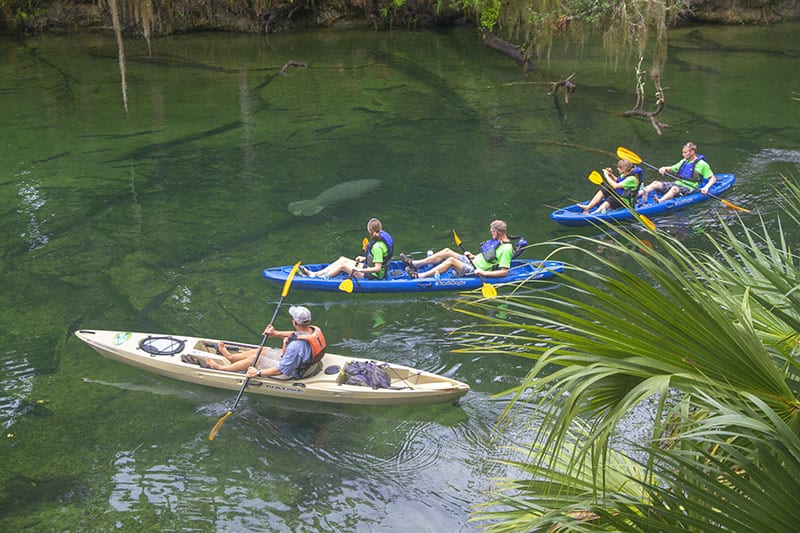
Florida has the largest concentration of freshwater springs in the world.
Estimated reading time: 12 minutes
By Dave G. Houser
Although Weeki Wachee Springs and Rainbow Springs are the most popular Florida freshwater springs, Geologists have identified more than 700 additional springs scattered across the state. In fact, Florida has the largest concentration of freshwater springs in the world.
The Sunshine State’s multitude of natural springs offers visiting RVers a refreshing, low-cost vacation alternative to the state’s crowded and costly mega-theme parks.
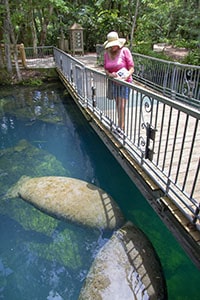
Springs bubble up in particular density across a swath of Central Florida, where many of the 15 state parks named for springs are located. We’ll visit a select half-dozen of them below.
Origin of Florida’s Springs
The origin of these springs is no mystery. Florida is underlain by a porous crust of limestone, defined in the lingo of geologists as karst topography. Rainwater enters the rock and slowly works its way through the limestone.
In the process, it forms an underwater drainage system that through the ages formed the great Florida Aquifer – the source of most of the state’s fresh water supply – and the water that feeds the springs.
Rising from very near the porous surface, the springs also exhibit a warm and constant temperature, usually 72-74 degrees.
Archaeological evidence indicates that people have been attracted to Florida’s freshwater springs for thousands of years, with Native Floridians finding them an ideal source of food and water.
Later explorers were drawn to the intriguing discharges of fresh water, including the Spanish conquistador Ponce de Leon who scoured the region in a legendary search for the Fountain of Youth.
Some springs came to be valued for their therapeutic qualities and people flocked to them in droves during the late 1800s and early 1900s to drink from and soak in the “medicinal waters.”
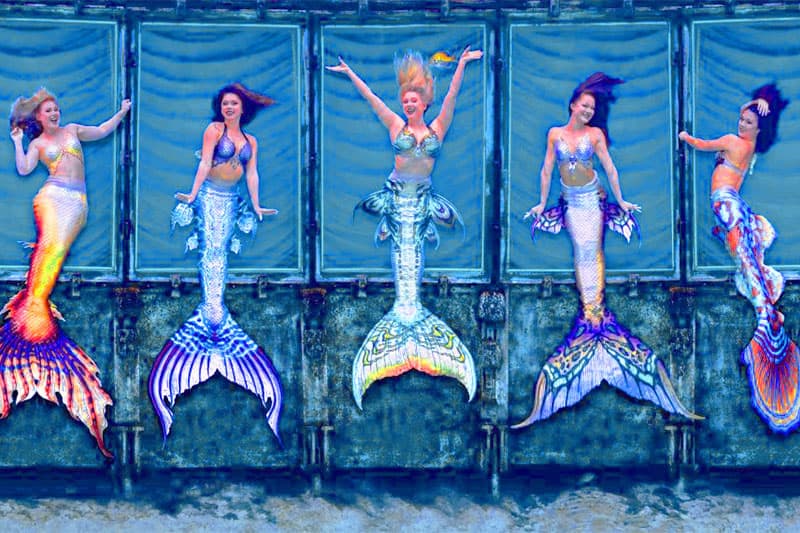
Before Disney, Florida’s Primary Attraction
While today’s mass of theme park-oriented visitors might never imagine it, Florida’s springs were once the state’s primary visitor attractions.
“Well before the advent of Disney World and other parks – from the 1930s well into the 70s – Silver, Rainbow, Homosassa and Weeki Wachee Springs were the main magnets of Florida tourism,” notes Martha Robinson, Communications Manager for Florida State Parks.
During their heyday, these springs operated as privately owned attractions, boasting entertainment, rides, ornamental gardens and wildlife exhibits.
All are now owned by the state, which is committed to returning them to a more natural condition, emphasizing nature over rides and other attractions.
Florida’s freshwater springs, however, continue to attract people with their unique natural beauty and recreational benefits. Swimming, snorkeling, scuba diving, canoeing, kayaking, hiking and wildlife viewing are typical of the recreational pursuits available at most springs.
So let’s spring into action here, taking a look at six springs – all in close proximity to Orlando – that represent the best of Florida’s amazing array of natural attractions.
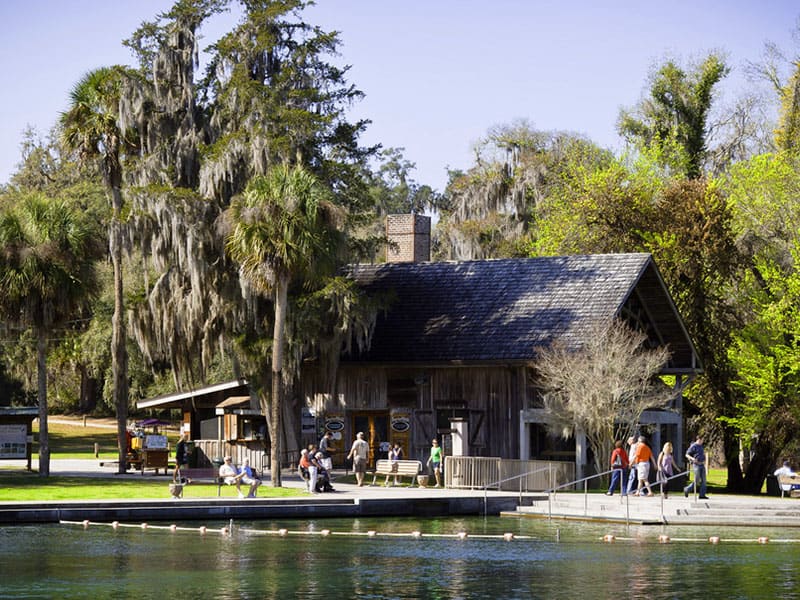
Ponce De Leon Springs State Park, DeLand, Florida
A little gem of a park, Ponce De Leon Springs State Park is located well off the beaten path six miles north of DeLand, where you can kick off a visit by cooking up your own pancake breakfast.
Folklore has it that Ponce de Leon discovered the Fountain of Youth here but there’s no solid proof to support the legend.
One reality is that Native Floridians resided around this Florida freshwater spring for thousands of years – as evidenced by a 6,000-year-old dugout canoe unearthed at the site. Local planters built a sugar mill beside the spring in 1830. However, it was torched by Union troops during the Civil War and later rebuilt.
By the 1880s the spring had become a winter resort, luring tourists with the promise of rejuvenation. In the 1950s it was further developed as an attraction, adding gardens, a jungle cruise and water circus.
Its fortunes faded with the advent of Disney World and the state acquired the property in 1982, redeveloping it as Ponce De Leon Springs State Park.
Today the old mill is home to a restaurant where folks line up each morning to grill pancakes, made from freshly stone-ground flour, right at their tables.
Once satiated, visitors can undertake a variety of activities. Many go for a swim in the tranquil spring, which discharges more than 15 million gallons of water a day – at a constant year-round 72 degrees.
Others stride out on the network of hiking trails in De Leon, or canoe, kayak or paddleboard along the spring run, known as Spring Garden Creek.
If You Go:
Ponce De Leon Springs State Park
601 Ponce de Leon Blvd.
De Leon Springs FL 32130
Tel: (850) 836-4281
Open: 8 a.m. until sunset, 365 days a year
Admission: $6 per vehicle
Directions
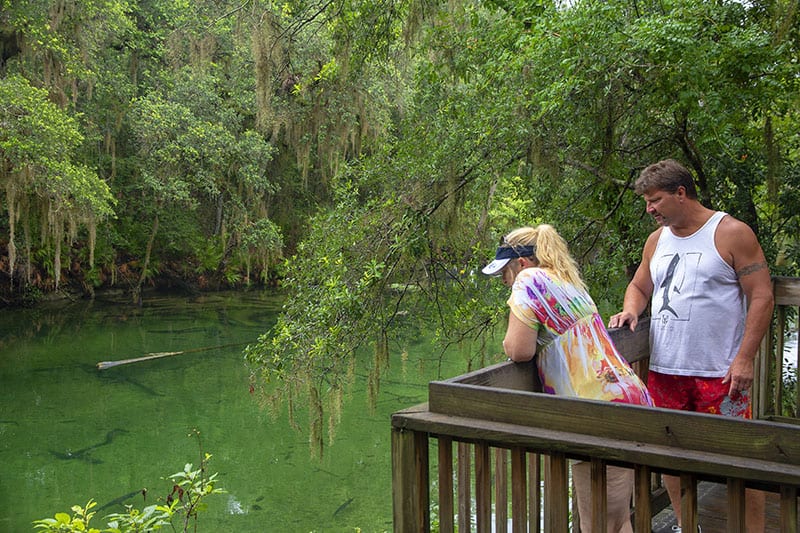
Florida Springs for Manatees: Blue Spring State Park, Orange City, Florida
Florida’s freshwater springs also includes Blue Spring State Park. It features a huge spring that discharges about 100 million gallons of water daily into the nearby St. Johns River, just west of Orange City and about 32 miles north of Orlando.
A year-round favorite among residents and visitors alike, Blue Spring reaches its peak in popularity from November to March when several hundred manatees crowd the spring run seeking the warmth of its constant 73-degree water. The lazy but lovable “sea cows” are easy to see from a boardwalk bordering the spring.
Boats (non-motorized) are okay when manatees are in residence. But since the spring is a legal refuge for manatees, swimming, snorkeling and diving are forbidden.
During the remainder of the year, the springs are open to swimmers, snorkelers, divers, boaters, hikers and fishermen. Park amenities include canoe and kayak rentals, a snack bar, picnic area and a campground with RV sites and six cabins.
If You Go:
Blue Spring State Park
601 Ponce de Leon Blvd.
De Leon Springs FL 32130
Tel: (800) 326-3521
Open: 8 a.m. until sunset, 365 days a year
Admission: $6 per vehicle
Directions
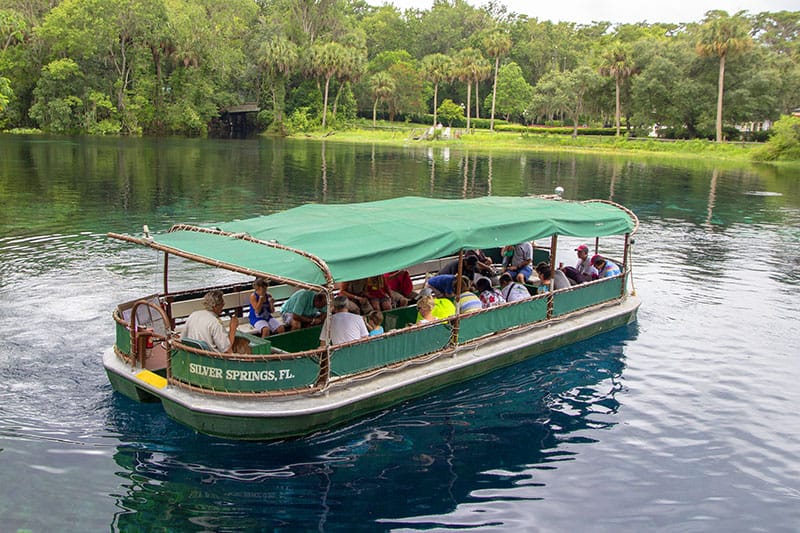
One of the Great Springs in Florida: Silver Springs State Park, Ocala, Florida
Silver Springs State Park, formerly Silver Springs Nature Theme Park, opened in 1878 as Florida’s very first tourist attraction. Situated on the eastern fringes of Ocala, Silver Springs once entertained generations of visitors. Its spectacles ranged from a reptile show and a giraffe exhibit to jungle cruises, gondola rides, and world-famous glass bottom boat rides.
This Florida freshwater spring and its pristine run – the 4.5-mile-long Silver River – have also served as the setting for countless movies, including six Tarzan films.
While most of the rides and man-made attractions are long gone, the iconic glass bottom boats remain. And they still serve their mission as the easiest means of exploring the park’s natural environs.
The overall focus at Silver Springs, however, is on the park’s many recreational activities. They include canoeing, kayaking, hiking, bicycling, camping and wildlife viewing.
If You Go:
Silver Springs State Park
5656 E Silver Springs Blvd.
Silver Springs, FL 34488
Tel: (352) 261-5840
Open: 8 a.m. until sunset, 365 days a year
Admission: $2 per person, under 6 years free
Directions
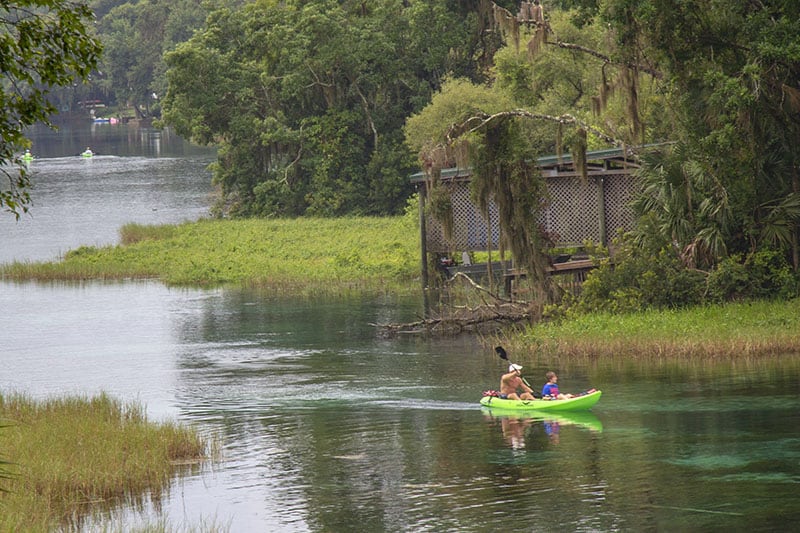
Rainbow Springs State Park, Dunnellon, Florida
Rainbow Springs State Park, three miles north of Dunnellon, has gained the lofty designation of a National Natural Landmark. Such recognition seems justified when viewing the headspring from a lofty overlook near the park entrance.
It is an exquisite scene – the glassy crystal-clear water flanked by forests and fringed by marsh grass. It all looks as if it was set on canvas by an artist.
Rainbow Springs State Park’s beauty attracted early developers to Florida. They dredged the spring run for glass bottom boats. They also built waterfalls, planted ornamental gardens and tacked on a zoo and a monorail.
Here, too, newer theme parks lured away the tourists and the park closed. But it reopened in the mid-1990s as a state park.
The gardens and waterfalls were maintained as a reminder of the park’s cultural heritage, but the monorail was replaced in favor of nature trails that meander through the gardens and hilly forests surrounding the spring.
Not surprisingly, picnicking is one of the most popular pastimes in Rainbow Springs State Park, aided by a number of covered pavilions nicely equipped for grilling.
Most visitors, however, come to Rainbow Springs State Park to recreate in the refreshing headspring and beyond on the Rainbow River, pursuing such activities as swimming, snorkeling, canoeing, kayaking, tubing and fishing. The park also features a full-service campground with 60 sites for both RVs and tents.
If You Go:
Rainbow Springs State
19158 S.W. 81st Place Road
Dunnellon FL 34432
Tel: (352) 465-8555
Open: 8 a.m. to sunset, 365 days a year
Admission: fees vary – see all fees
Directions
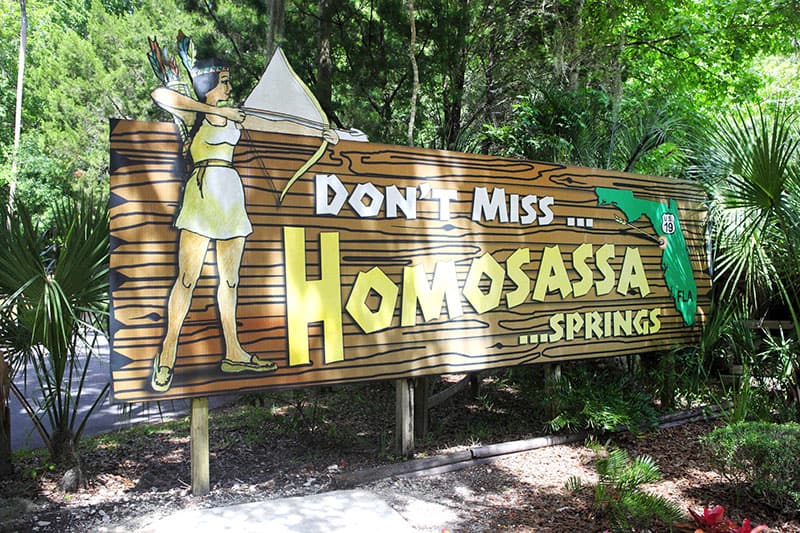
Ellie Schiller Homosassa Springs Wildlife State Park, Homosassa Springs, Florida
Ellie Schiller Homosassa Springs Wildlife State Park is located in west-central Florida. It is named in memory of the late environmentalist and park benefactor, Ellie Schiller.
Homosassa Springs’ centerpiece is a voluminous Florida freshwater spring producing millions of gallons of water a day. Rainbow Springs State Park, however, focuses entirely to wildlife. Most of the park’s animals and birds are Florida natives that can be observed at close range in relatively natural settings.
A narrated jungle cruise along Pepper Creek leads to the zoological heart of the park. A network of trails and boardwalks circulates among exhibits featuring black bears, Florida panthers, cougars, red wolves, key deer and a wide variety of birds and reptiles.
Most attention here, however, focuses on Homosassa Springs Wildlife State Park’s resident manatees that can be observed year-round from a floating observatory.
If You Go:
Ellie Schiller Homosassa Springs Wildlife State Park
4150 S. Suncoast Blvd.
Homosassa FL 34446
Tel: (352) 628-5343
Open: 9 a.m. to 5:30 p.m. Ticket counters close at 4:45 p.m.
Admission: Adults (age 13+) $13 / children (ages 6-12) $5 / children 5 and under admitted free.
Directions
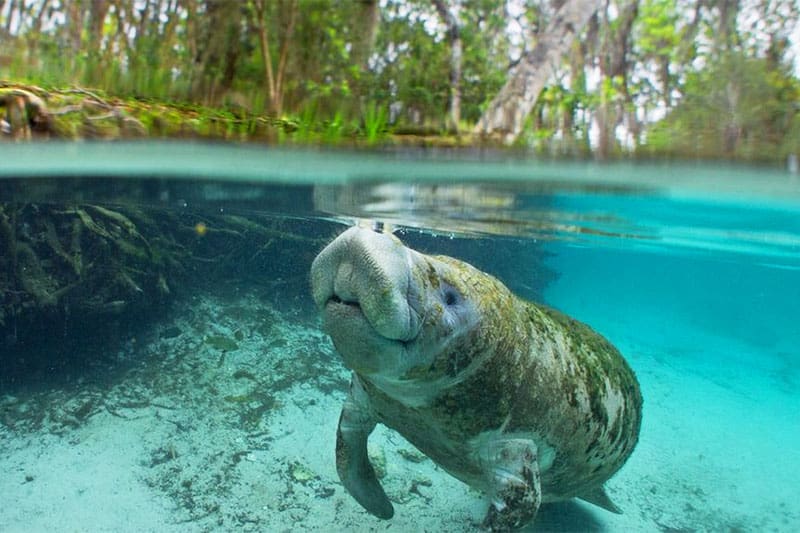
Weeki Wachee Springs State Park, Spring Hill, Florida
Weeki Wachee Springs State Park is world famous for its mermaid show that has been delighting visitors since 1947. It is the one attraction-based Florida freshwater spring that has withstood the challenge of Disney World and subsequent mega-theme parks to survive in today’s highly competitive tourism market.
Park facilities nestle around a mighty spring that discharges an average of 112 million gallons a day. More notable than its magnitude is the spring’s 400+ foot depth, making it the nation’s deepest naturally formed spring.
You may also enjoy: A Florida Road Trip: The Gulf Coast / 8 Great Florida Botanical Gardens / Florida’s Real Alligator Alley
For all the grandeur of its spring, it is the mermaids who continue to steal the show at Weeki Wachee Springs State Park. They perform several times daily before the large glass windows of a 400-seat theater embedded in limestone 16 feet beneath the surface of the spring.
Animal shows are part of the entertainment mix, featuring handlers who display and discuss a variety of domesticated birds and reptiles – demonstrations that are informative though not terribly exciting.
There is, however, plenty of excitement in store for youngsters and the young at heart on the high-speed body slides and flume rides at Buccaneer Bay, Florida’s only spring-fed water park.
The Bay, open March through October, also features a tube ride, an area for swimming and snorkeling, and some white sand beaches – one with a volleyball court.
Visitors can join a riverboat ride along a seven-mile run of the Weeki Wachee River and paddlers can ply the same stretch of river utilizing canoes and kayaks rented from the park concessionaire.
If You Go:
Weeki Wachee Springs State Park
6131 Commercial Way
Spring Hill, FL 34606
Tel: (352) 610-5660
Open: 9 a.m. to 5:30 p.m.
Admission: $13 for adults / $8 children (ages 6 to 12) / children 5 years and under admitted free.
Directions
For more information for all Florida freshwater springs, go to www.floridastateparks.org.

Leave a Reply